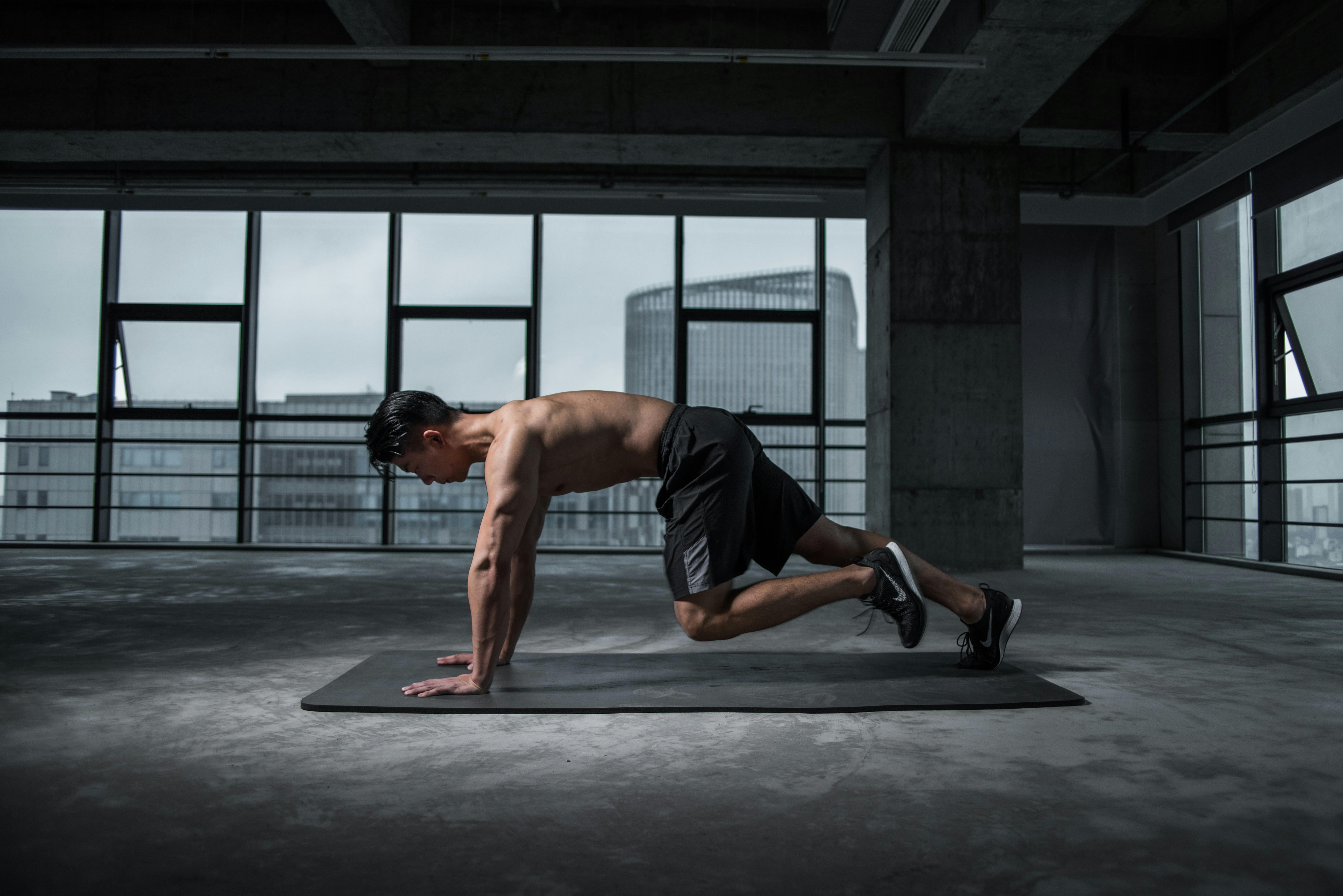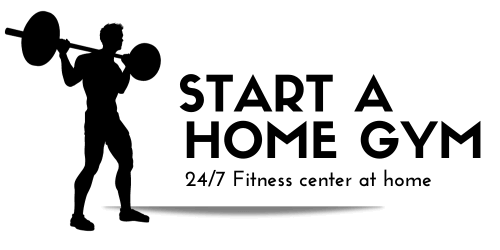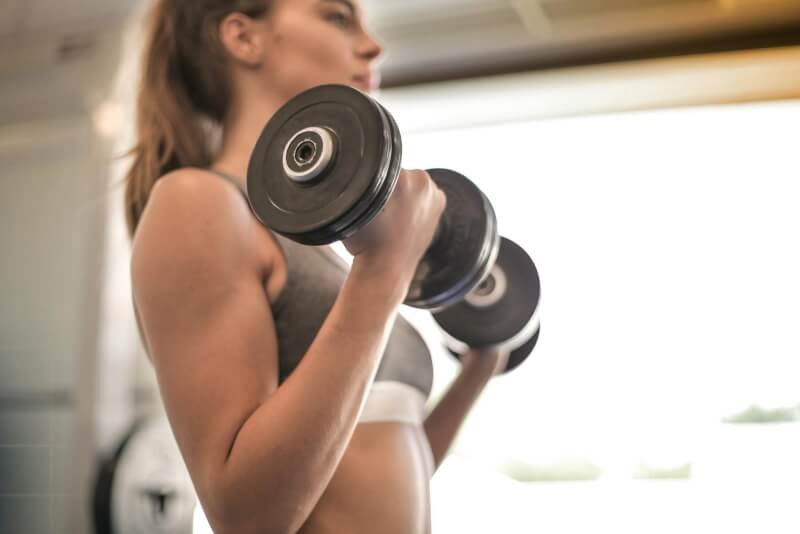Looking to get your heart rate up and burn some calories without the need for expensive equipment? Look no further! In this article, we explore a variety of no-equipment cardio workout options that are perfect for home gyms. Whether you’re a beginner or a fitness enthusiast, these exercises will help you stay active, improve your cardiovascular health, and achieve your fitness goals right from the comfort of your own home. So, grab your water bottle and get ready to sweat it out with these effective no-equipment cardio workouts!
Bodyweight Exercises for Cardio
1.1 Jumping Jacks
Jumping jacks are a classic and effective bodyweight exercise for cardio. They get your heart rate up and work multiple muscle groups at the same time. To perform jumping jacks, stand with your feet together and arms at your side. Jump up, spreading your legs out wide and raising your arms above your head in one fluid motion. Jump again to return to the starting position. Repeat for a prescribed amount of time or number of repetitions.
1.2 High Knees
High knees are a great way to engage your core, improve your cardiovascular endurance, and increase your leg strength. Stand tall with your feet hip-width apart. Lift one knee as high as you can while driving the opposite arm forward. Alternate the movement to maintain a quick and rhythmic pace. You can perform high knees in place or move forward with each step. Aim to bring your knees up to hip level and maintain a quick pace to get your heart rate up.
1.3 Mountain Climbers
Mountain climbers are a challenging exercise that targets your core, shoulders, and legs while providing a great cardiovascular workout. Start in a high plank position, with your hands directly under your shoulders and your body in a straight line. Drive one knee towards your chest, keeping your core engaged, then quickly switch legs, as if you are running in place. Continue this alternating motion, keeping your hips low and your core tight. Increase the speed to increase the intensity of the exercise.
1.4 Burpees
Burpees are a full-body exercise that combines strength, cardio, and explosiveness. Start in a standing position with your feet hip-width apart. Lower your body into a squat position, with your hands on the floor in front of you. Kick your feet back to a push-up position, then immediately return your feet to the squat position. Jump explosively into the air, reaching your arms overhead. Land softly and immediately lower back into a squat to begin the next repetition. Burpees can be challenging, but they are incredibly effective for cardiovascular conditioning.
1.5 Jumping Lunges
Jumping lunges are a dynamic and powerful exercise that targets your legs, glutes, and core while elevating your heart rate. Start by standing with your feet shoulder-width apart, then take a step forward with your right leg and lower your body into a lunge position. From this lunge position, explosively jump off the ground, switching the positions of your legs mid-air. Land softly with your left leg forward and immediately lower into the next lunge. Continue alternating the lunge position with a jumping motion. This exercise requires coordination and balance, but it’s an excellent way to incorporate cardio into your workout routine.
Plyometric Exercises
2.1 Box Jumps
Box jumps are a plyometric exercise that improves explosiveness, power, and cardiovascular endurance. Find a sturdy box or platform that is a comfortable height for you. Stand facing the box with your feet shoulder-width apart. Bend your knees, swing your arms back, and then jump onto the box, landing softly with both feet on top. Step down carefully and repeat for the desired number of repetitions. Start with a lower box height and gradually increase the height as you become more comfortable and proficient with the exercise.
2.2 Plyometric Push-Ups
Plyometric push-ups are a challenging variation of the traditional push-up that involves explosive pushing movements. Start in a high plank position with your hands slightly wider than shoulder-width apart. Lower your chest towards the floor, then push up explosively, lifting your hands off the ground as your upper body becomes airborne. Land softly with your hands returning to the starting position, ready for the next repetition. This exercise targets your chest, shoulders, triceps, and engages your core. It also elevates your heart rate, making it an effective cardio exercise.
2.3 Switch Lunges
Switch lunges are a plyometric exercise that targets your legs, glutes, and cardiovascular system. Start in a lunge position with your right leg forward and left leg extended behind you. Lower into a lunge, then explosively jump straight up, simultaneously switching the positions of your legs mid-air. Land softly with your left leg forward and your right leg extended behind you. Immediately drop into a lunge position and repeat the movement. This exercise requires coordination and balance, but it’s an excellent way to add intensity to your cardio routine.
2.4 Tuck Jumps
Tuck jumps are a high-intensity plyometric exercise that targets your legs, glutes, and core while elevating your heart rate. Start in a standing position with your feet hip-width apart and arms by your side. Bend your knees into a squat position, then explode vertically, bringing your knees up towards your chest as you tuck them in mid-air. Land softly with your knees slightly bent and immediately transition into the next repetition. The quick and explosive nature of tuck jumps makes them an effective cardiovascular exercise.
2.5 Skater Jumps
Skater jumps are a dynamic exercise that targets your legs, glutes, and cardiovascular system. Start in a slight squat position with your knees bent, and your weight on one leg. Leap sideways, extending your opposite leg behind you and swinging the opposite arm across your body. Land softly on the other leg, absorbing the impact, then immediately leap back to the starting position on the other side. Repeat the movement from side to side, maintaining a quick and rhythmic pace. Skater jumps mimic the movement of a skater on ice, making it a fun and engaging exercise.

HIIT (High-Intensity Interval Training)
3.1 Tabata Protocol
The Tabata protocol is a popular form of HIIT (High-Intensity Interval Training) that consists of 20 seconds of intense exercise followed by 10 seconds of rest, repeated for a total of 4 minutes. You can choose any exercise or combination of exercises for the intervals, such as burpees, high knees, or jumping jacks. The key is to maintain maximum effort during the 20-second work intervals and use the 10-second rest intervals to recover and prepare for the next set. Tabata workouts are quick and efficient, making them a great option for those with limited time but still want an effective cardio workout.
3.2 30-20-10 Workout
The 30-20-10 workout is another form of HIIT that can be modified to suit different fitness levels. The workout consists of 30 seconds of moderate-intensity exercise, followed by 20 seconds of increased intensity, and finally, 10 seconds of maximum effort. Repeat this sequence for a total of 5 minutes, and then take a short rest before starting the next round. You can choose any exercise for this workout, such as running in place, jumping rope, or bodyweight exercises. This workout structure allows you to progressively increase the intensity and challenge yourself as you go.
3.3 EMOM (Every Minute On the Minute)
EMOM workouts are a popular form of HIIT that involves performing a specific exercise or set of exercises at the start of every minute. You complete the prescribed number of repetitions within that minute and rest until the next minute begins. This format allows you to control the intensity and pace of your workout based on your fitness level. Choose compound exercises like burpees, push-ups, squats, or a combination of movements to maximize the cardiovascular benefits of the workout. EMOM workouts are time-efficient and provide a great cardiovascular challenge.
3.4 AMRAP (As Many Rounds As Possible)
AMRAP workouts are a form of HIIT that challenges you to complete as many rounds as possible of a specific set of exercises within a given time frame. This format encourages you to work at a high intensity, completing the movements quickly and efficiently. Choose a combination of bodyweight exercises and perform them back-to-back without any rest. Keep track of the number of rounds completed, and try to beat your previous record each time you do the workout. AMRAP workouts are an excellent way to improve your cardiovascular fitness and overall endurance.
3.5 Circuit Training
Circuit training is a versatile and effective way to incorporate cardio into your workout routine. It involves performing a series of exercises in a specific order, with minimal rest between each exercise. You can choose any combination of bodyweight exercises, plyometric movements, or even incorporate weights if you have access to them. Aim to complete each exercise for a specific duration or number of repetitions before moving on to the next one. Circuit training keeps your heart rate elevated throughout the workout, providing an excellent cardiovascular challenge.
Dance-based Workouts
4.1 Zumba
Zumba is a popular dance-based workout that combines energetic dance movements with music to provide a fun and effective cardio workout. It incorporates various dance styles, such as salsa, merengue, and hip-hop, to create a dynamic and engaging exercise routine. Zumba classes are typically led by instructors who guide you through choreographed routines, keeping you motivated and ensuring proper form. This workout not only improves cardiovascular fitness but also enhances coordination, balance, and flexibility.
4.2 Hip Hop Dance Workouts
Hip hop dance workouts are a high-energy and expressive way to get your heart pumping. These workouts are often inspired by urban dance styles and include a combination of choreographed routines and freestyle movements. You can find hip hop dance workouts online or participate in group classes if available. The fast-paced nature of hip hop dance engages multiple muscle groups and requires coordination, making it an effective cardio exercise.
4.3 Latin Dance Workouts
Latin dance workouts, such as salsa, samba, and bachata, are not only a great way to explore different cultures but also provide a fantastic cardio workout. These dynamic and rhythmic dance styles involve continuous movement and shifting of body weight, requiring stamina, coordination, and balance. You can join Latin dance classes or follow online tutorials to learn the steps and routines. Latin dance workouts are known for their infectious beats and joyful atmosphere, making them an enjoyable cardio option.
4.4 Cardio Dance Workouts
Cardio dance workouts are designed specifically to improve cardiovascular fitness while incorporating dance movements and routines. These workouts typically involve a combination of aerobic exercises, dance-inspired movements, and upbeat music to keep you motivated and engaged. Cardio dance workouts are versatile, allowing you to choose from a variety of styles, such as jazzercise, dance fitness, or even Bollywood dance. They are suitable for all fitness levels and provide a fun and effective way to burn calories and improve cardiovascular endurance.
4.5 Bollywood Dance Workouts
Bollywood dance workouts are energetic and vibrant, incorporating traditional Indian dance movements with modern influences. These workouts are known for their lively music, colorful costumes, and expressive choreography. Bollywood dance involves a combination of cardio exercises, rhythmic footwork, and expressive hand gestures. It provides a complete body workout, targeting various muscle groups while enhancing coordination, flexibility, and cardiovascular endurance. You can find Bollywood dance workouts online or join classes to experience the energetic and joyful nature of this dance style.
Jump Rope Cardio
5.1 Basic Jump
Jumping rope is an excellent way to improve cardiovascular fitness, coordination, and endurance. Start with the basic jump, which involves jumping with both feet together as the rope passes under you. Keep your elbows close to your sides and use your wrists to rotate the rope. Start with a comfortable pace and gradually increase the speed as you become more comfortable. A jump rope is an inexpensive and portable piece of equipment that you can use anywhere and at any time to get a great cardio workout.
5.2 Double Unders
Double unders are an advanced jump rope exercise that requires timing, coordination, and cardiovascular endurance. Begin with a basic jump, but instead of the rope passing under you once, you need to spin it twice per jump. This means the rope passes under your feet twice before you land. Double unders are more challenging and require a faster wrist rotation and higher jump. Practice the timing and gradually increase the speed as you improve. Double unders significantly increase the intensity of your jump rope cardio workout.
5.3 High Knees
Incorporating high knees into your jump rope routine adds an extra cardiovascular challenge and engages your core and legs. Start with a basic jump, but lift your knees up towards your chest as you jump. The goal is to bring your knees up as high as possible while maintaining a steady rhythm. This movement elevates your heart rate, intensifies the workout, and improves coordination. High knees are a great way to mix up your jump rope routine and keep it challenging.
5.4 Crisscross
Crisscross is a fun and dynamic jump rope exercise that challenges your coordination and cardiovascular endurance. Begin with a basic jump, but as the rope passes under you, cross your arms in front of your body. The rope should pass under your arms in an X shape. Uncross your arms on the next jump, then cross them again in the opposite direction on the following jump. Continue alternating the crisscross motion with your arms as you jump. Crisscross adds diversity to your jump rope workout and provides an extra challenge for your cardiovascular system.
5.5 Jump Rope Sprint
Jump rope sprints are a high-intensity cardio exercise that mimics the intensity and explosive bursts of sprinting. Begin with a basic jump rope movement at a comfortable pace, and then suddenly increase the speed to a sprint for a specified amount of time or number of jumps. After the sprint, return to the regular jump rope pace for recovery. Repeat this cycle, alternating between sprinting and recovery periods. Jump rope sprints elevate your heart rate quickly and effectively, providing a challenging cardiovascular workout.
Staircase Workout
6.1 Stair Running
Stair running is a challenging and effective way to incorporate cardio into your workout routine. Find a flight of stairs, whether indoors or outdoors, and begin by running up the stairs with a quick and explosive movement. Use your arms to propel yourself upward and maintain a steady pace. Reach the top of the stairs, then carefully walk or jog back down for recovery. Repeat for a prescribed number of sets or duration. Stair running engages your leg muscles, core, and cardiovascular system, making it a full-body workout.
6.2 Step-Ups
Step-ups are a simple and effective exercise that targets your legs, glutes, and cardiovascular system. Find a sturdy step or platform that is knee height or slightly higher. Step onto the platform with one foot, engaging your leg muscles to lift your body weight. Bring your other foot onto the platform, then step back down with one foot at a time. Repeat the movement, alternating the leading foot. To increase the intensity, perform step-ups at a quick pace, incorporating a small jump between steps. Step-ups are a versatile exercise that can be adjusted to your fitness level.
6.3 Stair Hops
Stair hops are a dynamic plyometric exercise that challenges your leg strength, coordination, and cardiovascular endurance. Stand facing a flight of stairs with your feet hip-width apart. Explosively jump up, lifting your knees towards your chest, and land softly on the next step. Continuously hop up the stairs, maintaining a quick and rhythmic pace. Use your arms for balance and to generate power. Stair hops are an advanced exercise that requires agility and balance, but they provide an excellent cardio workout.
6.4 Staircase Circuit
A staircase circuit involves performing different exercises on each step of a flight of stairs, targeting various muscle groups and providing a cardiovascular challenge. Start at the bottom step and perform a set of exercises, such as squats, lunges, or push-ups. Move up to the next step and repeat a different exercise. Continue working your way up the stairs, assigning a specific exercise to each step. This circuit format keeps your heart rate elevated, engages multiple muscle groups, and allows for a customizable workout based on your fitness level.
6.5 Lunge Walks
Lunge walks are a lower body exercise that targets your legs, glutes, and cardiovascular system. Start at the bottom of a flight of stairs with your feet hip-width apart. Take a large step forward with your right foot and lower your body into a lunge position, with both knees forming 90-degree angles. Push off with your back foot and step forward with your left foot into the next lunge. Continue lunging up the stairs, alternating legs with each step. Lunge walks engage your leg muscles and provide an intense cardiovascular workout.

Shadow Boxing
7.1 Jab Cross Combos
Shadow boxing is an effective cardio workout that also helps improve coordination, upper body strength, and endurance. Start by standing in front of a mirror or open space. Begin by throwing quick jabs with your front hand, followed by powerful crosses with your back hand. Alternate between jabs and crosses, focusing on maintaining proper form and keeping up a steady pace. You can also incorporate footwork, head movement, and hooks into your shadow boxing routine. Shadow boxing allows you to engage your entire body and elevate your heart rate while simulating the movements of a real boxing match.
7.2 Hooks and Uppercuts
Incorporating hooks and uppercuts into your shadow boxing routine adds variety and intensity. After throwing jabs and crosses, step into hooks by rotating your hips and shoulders while keeping your elbows at a 90-degree angle. Focus on engaging your core and using your entire body for power. Uppercuts involve bending your knees slightly and driving your punches upwards from below, targeting the chin and body. Practice alternating hooks and uppercuts, combining them with jabs and crosses for a complete shadow boxing workout that elevates your heart rate and engages your upper body.
7.3 Bob and Weave
Bobbing and weaving are defensive movements commonly used in boxing but can also provide a great cardiovascular workout. Start by assuming a boxing stance with your knees slightly bent, hands protecting your face, and feet shoulder-width apart. Practice bending at the knees and waist to “bob” or duck under imaginary punches, then quickly rise back up to your stance. You can also incorporate lateral movements by “weaving” from side to side, evading imaginary punches. These movements engage your core, legs, and cardiovascular system, offering a unique cardio workout that also improves agility and coordination.
7.4 Speed Bag Drills
Speed bags are small, air-filled punching bags that are commonly used in boxing training. Performing speed bag drills without the bag itself still provides a great cardiovascular workout. Assume a boxing stance and imagine a speed bag in front of you. Begin by lightly punching the imaginary bag with your knuckles, starting at a slow pace and gradually increasing the speed. Try to maintain a steady rhythm and quick punches. Speed bag drills engage your shoulders, arms, and upper back while keeping your heart rate elevated.
7.5 Defense Techniques
Incorporating defense techniques into your shadow boxing routine adds a unique challenge and further engages your cardiovascular system. Practice slipping punches by swaying your upper body from side to side, evading and counterpunching in one fluid motion. Incorporate shoulder rolls by smoothly rolling your shoulders back and away from incoming punches, followed by quick counters. You can also practice blocking punches with your forearms or parrying punches away. These defensive movements require concentration, coordination, and cardiovascular endurance, offering a full-body workout while simulating a real boxing match.
Jumping Exercises
8.1 Jumping Jacks
Jumping jacks are a versatile cardio exercise that can be modified to suit different fitness levels. Start with your feet together and arms at your sides. Jump up, spreading your legs out wide while simultaneously raising your arms overhead. Jump again to return to the starting position. To increase the intensity, try performing jumping jacks at a faster pace or add a squat before each jump. Jumping jacks elevate your heart rate, engage multiple muscle groups, and provide a full-body workout.
8.2 Tuck Jumps
Tuck jumps are an advanced jumping exercise that incorporates explosive power and cardiovascular endurance. Begin by standing with your feet hip-width apart and arms at your sides. Bend your knees into a squat position, then explode upwards, pulling your knees in towards your chest mid-air. Extend your legs and land softly, immediately transitioning into the next repetition. Tuck jumps require coordination and power, making them an effective cardio exercise that targets your legs, glutes, and core.
8.3 Split Jumps
Split jumps are a dynamic exercise that provides a cardiovascular challenge while targeting your legs and glutes. Start in a lunge position with your right foot forward and left foot extended behind you. Lower into a lunge, then explosively jump up, switching the positions of your legs mid-air. Land softly with your left foot forward and your right foot extended behind you. Immediately drop into a lunge position and repeat the movement. Split jumps require coordination, balance, and explosive power, making them an effective and challenging cardio exercise.
8.4 Double Leg Jumps
Double leg jumps are a simple and effective jumping exercise that elevates your heart rate and engages your lower body. Start by standing with your feet shoulder-width apart and arms at your sides. Bend your knees into a quarter squat position, then jump up explosively, extending your knees and hips. Land softly with your knees slightly bent to cushion the impact, then immediately transition into the next repetition. Double leg jumps can be performed at a quick pace, increasing the intensity of the exercise and providing a cardio challenge.
8.5 Squat Jumps
Squat jumps combine the power of squats with the explosiveness of jumps, providing a complete lower body and cardiovascular workout. Start with your feet shoulder-width apart and arms at your sides. Lower your body into a squat position, keeping your weight in your heels and your knees tracking over your toes. Jump up explosively, extending your legs and arms. Land softly with your knees slightly bent, then immediately lower back into a squat to begin the next repetition. Squat jumps engage your quads, hamstrings, glutes, and cardiovascular system, making them an effective exercise for a full-body workout.
Running in Place
9.1 High Knees
Running in place with high knees is a fantastic cardio exercise that engages your core, quadriceps, and cardiovascular system. Start by standing with your feet hip-width apart and arms at your sides. Begin running in place, lifting your knees up towards your chest as high as possible while maintaining a quick pace. Focus on landing softly with each step and engaging your abdominal muscles to support your legs. High knees elevate your heart rate, improve coordination, and provide an intense cardio workout.
9.2 Butt Kicks
Butt kicks are a dynamic running exercise that targets your hamstrings, glutes, and cardiovascular system. Start by standing with your feet hip-width apart and arms at your sides. Begin running in place, kicking your heels up towards your glutes while maintaining a quick pace. Focus on bringing your heels as close to your glutes as possible and landing softly with each step. Butt kicks engage your lower body and elevate your heart rate, making them an effective cardio workout.
9.3 Running with Arm Movements
Running in place while incorporating arm movements adds an extra challenge for your cardiovascular system and engages your upper body. Start by standing with your feet hip-width apart and arms at your sides. Begin running in place, lifting your knees up and pumping your arms in sync with your leg movements. Focus on maintaining a quick pace and keep your core engaged throughout the exercise. Running with arm movements provides a full-body workout, improves coordination, and elevates your heart rate.
9.4 Side Shuffle
Side shuffling is a lateral movement exercise that targets your inner and outer thighs, glutes, and cardiovascular system. Start with your feet shoulder-width apart and your knees slightly bent. Take a step to the right with your right foot, then quickly bring your left foot towards your right foot. Continue side shuffling to the right for a specified distance or number of steps, then change direction and shuffle to the left. Maintain a quick and controlled pace, engaging your core and lower body. Side shuffling adds diversity to your cardio workout and challenges your coordination and lateral movements.
9.5 Quick Feet
Quick feet are a footwork exercise that enhances agility, coordination, and cardiovascular endurance. Start by standing with your feet shoulder-width apart and your knees slightly bent. Rapidly tap your feet on the ground, alternating between your toes and heels. Maintain a quick and rhythmic pace, focusing on keeping your movements light and your core engaged. Quick feet can be performed in place or while moving forward or backward. This exercise elevates your heart rate and adds a challenging cardio component to your workout routine.
Circuit Training
10.1 Push-Ups
Push-ups are a versatile exercise that engages your chest, shoulders, triceps, and core. Start in a high plank position with your hands slightly wider than shoulder-width apart. Lower your body towards the floor, keeping your elbows close to your sides. Push back up to the starting position. You can modify push-ups by performing them on your knees or against a wall for beginners or increase the difficulty by elevating your feet or incorporating explosive push-ups. Including push-ups in a circuit training routine keeps your heart rate elevated and provides a challenging upper body and cardiovascular workout.
10.2 Squats
Squats are a compound exercise that targets your quadriceps, hamstrings, glutes, and core. Begin by standing with your feet shoulder-width apart, toes slightly turned out, and arms at your sides. Lower your body into a squat position, keeping your weight in your heels and your knees tracking over your toes. Engage your core and drive through your heels to return to the starting position. To add intensity, perform jump squats by explosively jumping upwards from the squat position and landing softly back into the squat. Squats are an effective lower body exercise that elevates your heart rate, making them ideal for circuit training.
10.3 Lunges
Lunges are a functional lower body exercise that engages your quadriceps, hamstrings, glutes, and core. Begin by standing with your feet hip-width apart and your hands on your hips. Take a large step forward with your right foot, lowering your body into a lunge position with both knees forming 90-degree angles. Push off with your back foot and step back to the starting position. Repeat the movement on the opposite side. You can also perform walking lunges or add explosive jump lunges to increase the intensity and cardiovascular challenge. Lunges are a versatile exercise that can be adapted to your fitness level and included in circuit training routines.
10.4 Plank Jacks
Plank jacks are a dynamic exercise that targets your core, shoulders, and cardiovascular system. Start in a high plank position with your hands directly under your shoulders and your body in a straight line. Jump your feet apart, then quickly jump them back together. Continue this hopping motion while maintaining a strong plank position. Plank jacks engage your entire body and elevate your heart rate, making them an effective cardio exercise that also strengthens your core.
10.5 Tricep Dips
Tricep dips are an effective exercise that targets your triceps, shoulders, and core. Find a stable surface, such as a chair or bench. Sit on the edge with your hands gripping the edge, fingers pointing forward. Walk your feet forward, sliding your hips forward until your knees are at a 90-degree angle. Lower your body by bending your elbows until your triceps are parallel to the ground. Push back up to the starting position, engaging your triceps and core. To increase the intensity, perform tricep dips on one leg or elevate your feet. Tricep dips are a versatile exercise that lends itself well to circuit training and provides a cardio challenge.






